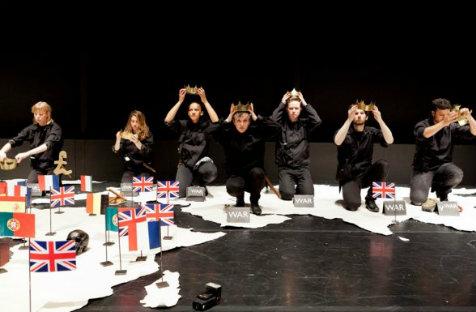True to the deceptively simple premise of its title, A History of Everything sees seven young actors present a recap of all of history, from the moment of performance back to the Big Bang. The first section focuses on human history, commencing with a ‘what if’ monologue and musing on the theory of an end of time as we know it. Thence comes a reversal and an intensely personal journey, returning to life from death and recapturing a lost youth.
Rolling back the black cloth on the floor, the performers revealed a large world map, filled with flags, logos, symbols of technology and ‘WAR’ signs scattered by actors as they moved about. They rewound human history in an exponential fashion, the date counting down on the wall behind them gradually speeding up from day by day to month to month, year to year. Once time before recorded history arrived, another monologue about inequality marked the start of an era heavily influenced by Jared Diamond’s theories on civilizations, neatly portrayed using symbols on the maps, before humans danced their steps back to Africa. The return through the sequence of evolution was danced out with a chalk artist calling the changes. With the end of Earth – or rather a pre-beginning – a secular thanksgiving to the conditions allowing life in this Universe was offered, and then a dance of light in darkness as the planets, stars and galaxies moved back to the Big Bang itself…
The structure of A History of Everything was reminiscent of Richard Dawkins’ The Ancestor’s Tale, but went even further, beyond the first cell to divide and replicate, to a solar system, a young galaxy, a universe contracting back to its first point, until a blinding light flared in the darkness, and the counter on the wall rapidly counted back up to the present, returning us to the here and now, and thundering applause for the performers.
The thoughtful use of the exponential return through time allowed more room for humans, thus ensuring closer audience interest. From the personal intimacy of today’s funeral notice to a global outbreak of ‘Gangnam Style’, family tales of wartime to stirring speeches and atomic bombs, the stark presentation covered an idiosyncratic view of human history. The cultural focus shifted from the genesis of Big Brother to the rising of Venus from the waves, and then back to cave paintings. The production’s strength was the focus on highly individual, quirky landmarks alongside the space race, colonisation, and outbreaks of diseases and ideas, rather than attempting a totally comprehensive coverage of every single noteworthy moment from the beginning of history.
The delivery of 20th and 21st century moments of note had an immediate appeal, with dry and absurdist humour employed to depict product launches and confessional moments, and dark moments tackled without apology or attempt to gloss over horrors such as Abu Ghraib or the Holocaust. While the performers demonstrated solid acting skills in the section on human history, there was a compassionate aspect to their treatment of reverse journey through the evolutionary process. The voice calling out shared common ancestors while describing physical changes and abilities while two forms wriggled, writhed and eventually dwindled away to a single cell evoked a deeper pathos and sense of wonder than expected from a stage performance. Similarly, the return through the creation of the solar system and beyond adroitly avoided clichés of science fair presentations by removing spoken speculation and simply giving us time passing, lights moving in blackness, and space for our imaginations to bridge the void.
The deceptively basic set held many props and costume changes in easily accessible boxes for the frenetically paced early part of the show, but allowed everything to fade to black as the focus shifted. The props and costumes themselves were simple and evocative, many serving multiple duties, all quickly acquired and discarded. Lighting was integral to the performance; the moments of total blackout particularly impressed. The sound design was flawless, accompanying changes in pace as well as providing cues for historical change. Silence was used potently.
Beautifully structured, well-researched and compellingly presented, A History of Everything does more than present 14 billion years in 90 minutes; it brings us back to the here and now with a renewed appreciation for life and our place in the world.
Rating: 4 ½ stars out of 5
A History of Everything
Presented by Ontroerend Goed in collaboration with Sydney Theatre Company
In association with Stadsschouwburg Amsterdam, Drum Theatre Plymouth and Richard Jordan Productions Ltd
Director: Alexander Devriendt
Text: Alexander Devriendt and Joeri Smet (with assistance of the cast, and with fragments of Sum by David Eagleman)
Scenographer and Costume Designer: Sophie De Somere
Lighting Designer: Lilith Tremmery
Assistant Lighting Technician: Michael Yallop
Scriptwriter and Research Assistant: Zachary Hatch
Performed by Zindzi Okenyo, Tahki Saul, Cameron Goodall, Charlotte De Bruyne, Nathalie Verbeke, Joeri Smet and Karolien De Bleser
Studio Underground, State Theatre Centre of WA, Perth Cultural Centre
14 – 22 February
Perth Festival 2013
www.perthfestival.com.au
8 February – 2 March





